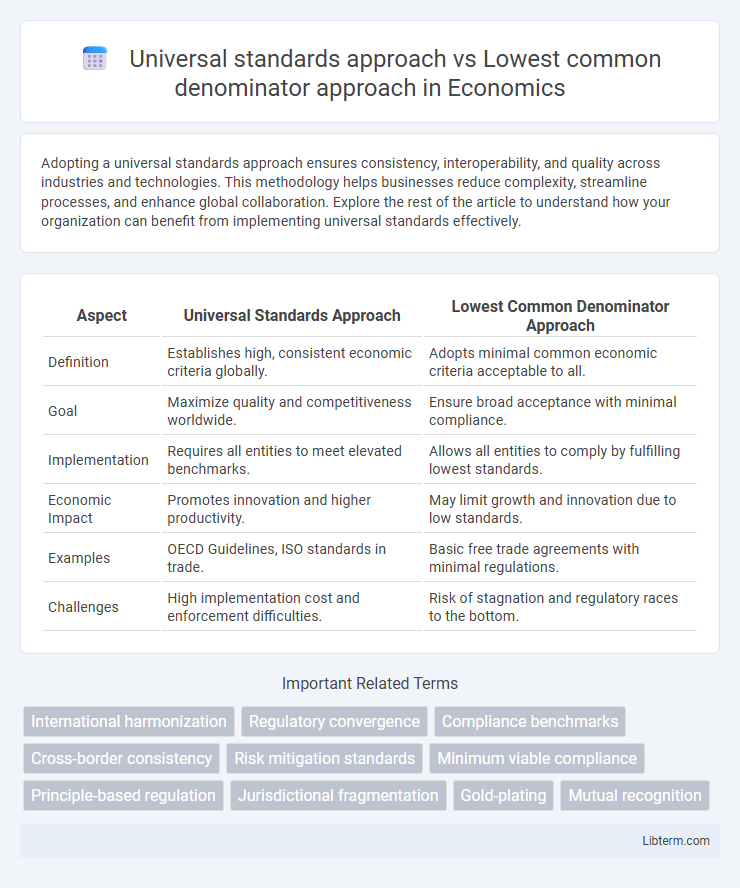Adopting a universal standards approach ensures consistency, interoperability, and quality across industries and technologies. This methodology helps businesses reduce complexity, streamline processes, and enhance global collaboration. Explore the rest of the article to understand how your organization can benefit from implementing universal standards effectively.
Table of Comparison
| Aspect | Universal Standards Approach | Lowest Common Denominator Approach |
|---|---|---|
| Definition | Establishes high, consistent economic criteria globally. | Adopts minimal common economic criteria acceptable to all. |
| Goal | Maximize quality and competitiveness worldwide. | Ensure broad acceptance with minimal compliance. |
| Implementation | Requires all entities to meet elevated benchmarks. | Allows all entities to comply by fulfilling lowest standards. |
| Economic Impact | Promotes innovation and higher productivity. | May limit growth and innovation due to low standards. |
| Examples | OECD Guidelines, ISO standards in trade. | Basic free trade agreements with minimal regulations. |
| Challenges | High implementation cost and enforcement difficulties. | Risk of stagnation and regulatory races to the bottom. |
Introduction to Standards in Policy Development
The Universal Standards Approach promotes the adoption of high, consistent criteria across all regions to ensure quality, safety, and interoperability in policy development. In contrast, the Lowest Common Denominator Approach sets minimum acceptable standards, enabling broader participation but potentially compromising effectiveness and innovation. Policymakers must balance inclusivity and ambition by evaluating the trade-offs between achieving widespread compliance and maintaining rigorous standards to address complex societal challenges.
Defining the Universal Standards Approach
The Universal Standards Approach establishes a comprehensive, inclusive framework designed to meet high-quality criteria applicable across diverse industries and regions. It emphasizes consistency, fairness, and sustainability by setting benchmarks that transcend local variations, promoting global interoperability and long-term impact. This approach contrasts with the Lowest Common Denominator Approach by prioritizing ambition and excellence rather than minimal compliance.
Understanding the Lowest Common Denominator Approach
The Lowest Common Denominator approach prioritizes creating standards that ensure compatibility across all systems by adopting the simplest, most widely supported features, often sacrificing advanced functionality for broader accessibility. This method emphasizes universal adoption and ease of implementation, which can limit innovation and performance due to the restrictions imposed by the minimal feature set. Understanding this approach is crucial for industries where interoperability and backward compatibility outweigh the need for cutting-edge capabilities.
Historical Context and Evolution of Both Approaches
The Universal Standards approach emerged from international efforts to create cohesive frameworks that facilitate global interoperability, such as the adoption of ISO standards during the mid-20th century. In contrast, the Lowest Common Denominator approach developed alongside early computing and telecommunications industries, focusing on compatibility by establishing minimal, widely acceptable criteria to ensure basic functionality across diverse systems. Over time, Universal Standards have evolved to support more complex and integrated systems, while the Lowest Common Denominator approach remains relevant in ensuring broad accessibility in technologically varied environments.
Key Features and Differences
The Universal Standards approach emphasizes consistent, high-quality criteria applicable across all contexts, ensuring inclusivity and maximizing global benchmarks, while the Lowest Common Denominator approach targets minimal, broadly acceptable standards, often compromising quality to accommodate diverse requirements. Key features of the Universal Standards include uniformity, scalability, and comprehensive compliance, contrasting with the Lowest Common Denominator's focus on basic functionality, flexibility, and minimal consensus. The fundamental difference lies in the Universal Standards aiming for optimal performance and uniform excellence, whereas the Lowest Common Denominator prioritizes widespread adoption through the least demanding criteria.
Advantages of Universal Standards
Universal standards enable consistent quality, interoperability, and compatibility across diverse markets and technologies, fostering global innovation and collaboration. They reduce complexity and costs by providing a common framework that manufacturers and developers can follow, ensuring products and services meet international benchmarks. This approach enhances consumer trust and facilitates regulatory compliance, boosting market access and competitiveness worldwide.
Limitations of Universal Standards
Universal standards often fail to accommodate cultural, economic, and regulatory diversity across global markets, restricting their practical application and acceptance. This inflexibility may cause resistance from local stakeholders who find these standards misaligned with regional needs, resulting in limited adoption and implementation challenges. Consequently, reliance solely on universal standards can lead to inefficiencies and reduced competitiveness in heterogeneous environments.
Pros and Cons of the Lowest Common Denominator Approach
The Lowest Common Denominator approach simplifies design by targeting the most basic features supported across all platforms, ensuring maximum compatibility and wider accessibility. However, this method often leads to underutilization of advanced capabilities, resulting in limited functionality and a suboptimal user experience on modern systems. By sacrificing innovation for uniformity, it can hinder performance improvements and reduce competitive differentiation in software or web development.
Impact on Global Cooperation and Compliance
The universal standards approach fosters global cooperation by establishing consistent regulations that facilitate interoperability and mutual recognition among nations, enhancing compliance through clear, shared expectations. In contrast, the lowest common denominator approach often leads to fragmented policies that hinder effective collaboration and create compliance gaps due to inconsistent or minimal requirements. Consequently, universal standards promote more robust and reliable global frameworks, driving higher levels of adherence and coordinated efforts across diverse stakeholders.
Choosing the Right Approach: Factors to Consider
Choosing between a Universal standards approach and a Lowest common denominator approach depends on factors like target audience diversity, product complexity, and regulatory requirements. The Universal standards approach ensures consistency, interoperability, and higher quality across various markets but may demand more resources and stricter compliance. The Lowest common denominator approach allows broader accessibility and faster implementation by simplifying features to meet minimal standards, though it risks compromising functionality and user experience.
Universal standards approach Infographic

 libterm.com
libterm.com